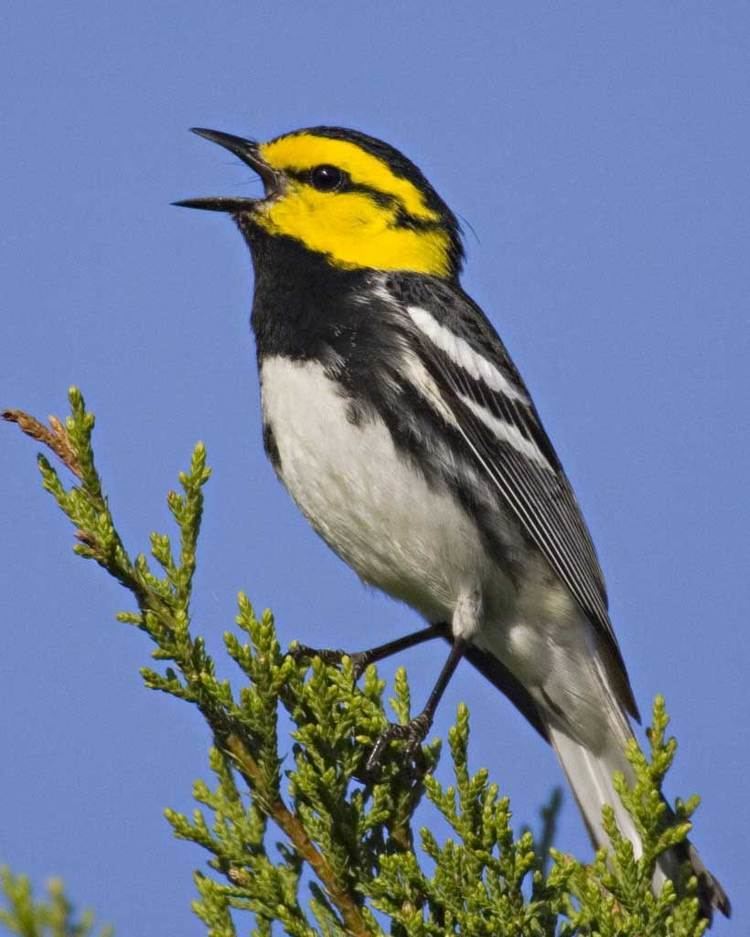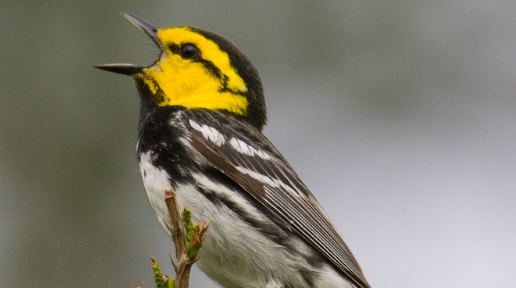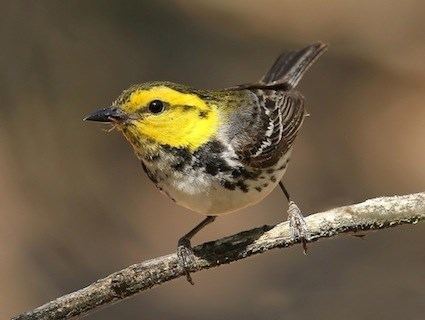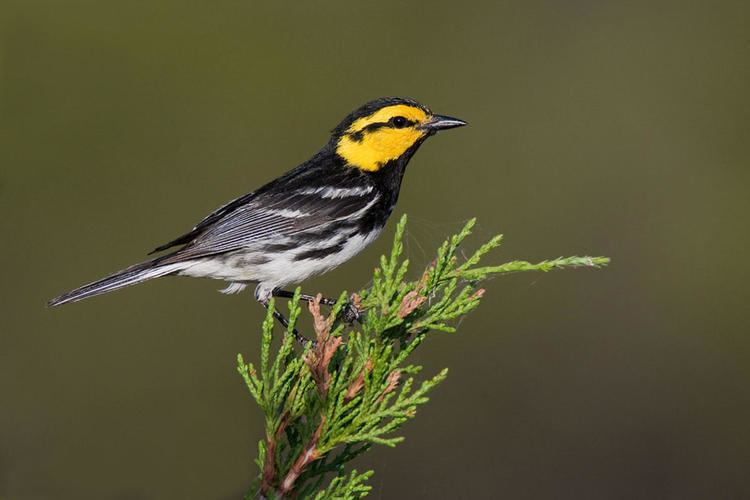Order Passeriformes Higher classification Setophaga | Phylum Chordata Family Parulidae Scientific name Setophaga chrysoparia Rank Species | |
 | ||
Similar New World warbler, Bird, Black‑capped vireo, Setophaga, Juniperus ashei | ||
Golden cheeked warbler song
The golden-cheeked warbler (Setophaga chrysoparia [formerly Dendroica chrysoparia]), also known as the gold finch of Texas, is an endangered species of bird that breeds in Central Texas, from Palo Pinto County southwestward along the eastern and southern edge of the Edwards Plateau to Kinney County. The golden-cheeked warbler is the only bird species with a breeding range confined to Texas.
Contents
- Golden cheeked warbler song
- Austin s warblers nesting golden cheeked warblers texas parks and wildlife official
- Historical Representation
- Habitat
- Behavior
- Conservation
- Population
- Threats
- Ecology
- Migration
- Nesting
- Location
- Feeding
- In fiction
- References

Austin s warblers nesting golden cheeked warblers texas parks and wildlife official
Historical Representation

The golden-cheeked warbler is very staggering because of its bright yellow cheeks that is counterposed by its black throat and back, but it is found more by its unique buzzing song emerging from the wooded canyons where it breeds. Golden-cheeked warblers form in 33 counties in central Texas and are dependent on Ashe Juniper (blueberry juniper or cedar) for their fine bark stripes for nesting reasons.
Habitat

The golden-cheeked warbler (GCWA) are endemic to Texas and no other quarters. Their habitat can range from moist, to dry areas around central and southern Texas. The nesting habitat in the further moist realms can be discovered in tall, closed canopy, compressed, mature stands of Ashe juniper trees along with Texas, shin, live, Lacey, and post oak trees. In the drier spheres of Texas the GCWAs can be found in upland juniper-oak woodlands off of flat topography. They use Ashe juniper bark and spider webs to build their nests. Females lay three to four eggs. When migration and winter hits the habitat stays relatively similar: a variety of short-lived evergreen forests with pines between 3,300 and 8,300 feet.
Behavior

Warblers only nest in Texas, primarily in juniper trees. However, they have also been found to nest in oak trees and cedar elms. During the winter warblers seek warmth in Mexico and Northern Central America.
After winter habitation, adult male warblers beat their population back to central nesting grounds by about 5 days in order to prepare competing for the attention of female warblers. Male warblers win attention of the females through their “chip” sounds which they also make as a warning call during times of possible danger.
Though male warblers are found either singing or searching for food, females carry the responsibility of nest building as well as keeping the eggs incubated. Warblers only nest once per season, laying between three and four eggs each time, which take an average of twelve days to hatch. Female warblers are considered shy and go more unnoticed compared to the always-singing males.
Warblers typically forge through grabbing insects from foliage and branches (forging strategy known as gleaning), and by resting at branch edges until the opportunity to snatch insects that fly past (strategy known as sallying).
Conservation
The breeding range of the warbler ranges to an extent of only about twenty acres, so spaces for habitation are limited. Many spots of warbler habitation have been cleared for the construction of houses, roads, and stores or to grow crops or grass for livestock. Juniper trees, the primary nesting place for warblers, have also been cut down and used for different timber products, especially before the 1940s. Other woodlands were flooded when large lakes were constructed. Sitting at the top of the endangered list (of species in North America) since May 1990, different projects are currently underway to restore the habitat of the Golden-Cheeked warbler. Efforts include The Safe Harbor agreement between Environmental Defense and the U.S. Fish and Wildlife Service, with the goal of rebuilding and creating new, safe habitats for the warbler (along with other endangered species). The Balcones Canyonlands Conservation Plan (BCCP) is another project responsible for building warbler preserves, with the goal of eventually adding a total of 41,000 acres to the warbler's habitat . These initiatives along with many others encourage landowners to learn more about the warbler (along with other species that inhabit their property) so local land owners may provide proper maintenance and protection of the warbler’s habitat. A project that significantly aided habitat restoration for the Warbler includes the U.S. Army’s (Fort Hood base) success in protecting the largest patch of juniper-oak trees.
Population
The most serious problems that are facing the Golden-cheeked warbler today, as the past, are the habitats that are being lost and destroyed due to their limited and specific habitat requirements. Between the years of 1962 and 1974, the population estimated to an 8 to 12% drop. Based on intensive surveys and observations, it was counted that in 2015, there were 716 singing males within 39 acres in Texas.
Threats
The main direct threat towards the golden-cheeked warbler is the rapid loss of habitats. Their specific habitat needs place warblers at an extremely vulnerable position where urban development has taken a significant amount of the available habitat away. Over-browsing by White-tailed deer, Goat, and Ungulate are also believed to be a source of habitat destruction as they decrease the survival rate of seedling oaks and other deciduous trees, which are a key habitat for warblers. Furthermore, the Brown-headed cowbird which is a Brood parasite that lays eggs in other nests, then abandons the nest is still being looked at on how great its impact is on the Golden-cheeked Warbler population because often these warblers will raise the other young birds as well as their own. As a result, the survivability of the young Golden-cheeked Warbler's is significantly reduced.
Ecology
The Golden-cheeked Warbler breeds in the juniper-oak woodlands. The bird starts to build its nest about 16–23 feet in the air around the end of March out of Ashe Juniper bark. The male Warbler will use song and physical abuse against other males to establish a territory in close proximity to the previous year’s territory. Warblers will stay with only one mate for the entirety of the breeding season. The female will produce 3-4 white eggs that are covered with brown and purple dots that will hatch 10–12 days later. The hatchlings grow rapidly and will leave the nest after 9–12 days. The family will stay together in their territory for up to a month, after which the hatchlings will become independent.
Migration
Golden-cheeked Warblers will only remain in Texas for the breeding season, from March to June. They will migrate with other songbird species along Mexico’s Sierra Madre Oriental. By the first week of March, the Warblers will return to Texas to breed. During the winter season (November–February), Warblers will travel to Guatemala, Nicaragua, Honduras, and Mexico.
Nesting
Once a female has chosen a mate, she alone builds the nest. The nest is made of strips of juniper bark, rootlets, grasses, cobwebs, cocoons, and can contain animal fur to line to the outer portions of the nest. Nearly all of warbler nests contain juniper bark, and it has been seen that females do not make a nest without the presence of the bark. Golden-cheeked warblers lay 3-4 creamy-white eggs, less than 3/4 inch long and ½ inch wide. Incubation begins one day before the last egg is laid. For approximately the 12 days, the female warbler incubates the eggs. The male is for the most part inattentive at this time, joining the female only when she forages for insects away from the nest.
Location
The Golden-cheeked Warbler can be found in numerous state parks within Texas. These parks include the “Colorado Bend State Park (SP), Dinosaur Valley SP, Garner SP, Guadalupe River SP, Honey Creek State Natural Area (SNA), Hill Country SNA, Kerr Management Area, Longhorn Cavern SNA, Lost Maples SNA, Meridian SP, Pedernales Falls SP, and Possum Kingdom SP.”
Feeding
The Golden-cheeked warbler is known to feed on various forms of insects and spiders, caterpillars are also noted as a primary source of food during the breeding season. This species is completely insectivorous. The method for catching insects is by plucking them from all surfaces by being able to reach them through flight.
In fiction
Susan Wittig Albert uses the golden-cheeked warbler as a plot device in her 1992 novel Thyme of Death.
